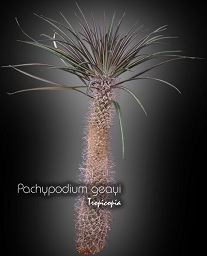Table of contents
Madagascar Palm

Latin Name: Pachypodium geayi
Category: Cactus & Succulent
Family: Apocynaceae
Origin: Madagascar
Climate: Arid Tropical
Growing Zones: 11, 9
Care Instructions
The Madagascar Palm (Pachypodium geayi) is a arid tropical plant that originates from Madagascar. This cactus & succulent plant belongs to the Apocynaceae family and is well-suited for growing in USDA zones 11, 9.
Complete Care Guide for Madagascar Palm (Pachypodium geayi)
Watering Requirements
The Madagascar Palm, or Pachypodium geayi, is a succulent plant that thrives in well-draining soil and requires careful attention to its watering needs. It is essential to allow the soil to dry out completely between waterings, as overwatering can lead to root rot. During the growing season, which typically spans from spring to early fall, water the plant every two to three weeks, ensuring that the water thoroughly penetrates the soil. In the winter months, reduce watering to once a month or even less, as the plant enters a dormant phase and requires minimal moisture. Always check the top inch of the soil; if it feels dry, it’s time to water. Remember, it’s better to underwater than overwater this unique succulent.
Light Conditions
The Madagascar Palm flourishes in bright, indirect sunlight, making it an ideal choice for indoor environments with ample natural light. Ideally, place your plant near a south or west-facing window where it can receive several hours of filtered sunlight each day. Direct sunlight can scorch the leaves, so it’s crucial to avoid placing it in harsh, direct light for extended periods. If you notice the plant stretching towards the light or its leaves becoming pale, it may be a sign that it needs more light. Conversely, if the leaves start to drop or turn yellow, it may be receiving too much direct sunlight. Adjusting its position accordingly will help maintain its health and vigor.
Soil Preferences
The Madagascar Palm prefers a well-draining soil mix that mimics its native habitat. A cactus or succulent potting mix is ideal, but you can also create your own by combining regular potting soil with sand and perlite in equal parts. This mixture ensures that excess water drains away quickly, preventing root rot. Additionally, consider adding a slow-release fertilizer during the growing season to provide essential nutrients. A balanced fertilizer with an N-P-K ratio of 10-10-10 is suitable, applied every four to six weeks. Be cautious not to over-fertilize, as this can lead to salt buildup in the soil, which can harm the plant.
Pests and Diseases
While the Madagascar Palm is relatively resilient, it can still be susceptible to common pests such as mealybugs, spider mites, and scale insects. Regularly inspect the leaves and stems for any signs of infestation. If you notice small, cotton-like masses (mealybugs) or tiny webs (spider mites), treat the plant with insecticidal soap or neem oil. For scale insects, gently wipe them off with a cotton swab dipped in rubbing alcohol. Additionally, ensure good air circulation around the plant to prevent fungal diseases, which can occur in overly humid conditions. If you notice any yellowing leaves or wilting, it may indicate root rot, often caused by overwatering. In such cases, remove the plant from its pot, trim away any rotten roots, and repot it in fresh, dry soil.
Special Care Tips
To keep your Madagascar Palm thriving, consider the following special care tips. First, ensure that your pot has drainage holes to prevent water accumulation. If you’re growing it indoors, rotate the plant occasionally to promote even growth and prevent it from leaning towards the light source. During the growing season, you can also mist the leaves occasionally to increase humidity, especially in dry indoor environments. However, avoid getting water on the stem to prevent rot. If you live in a region with frost, it’s crucial to bring the plant indoors during colder months, as it is not frost-tolerant. Lastly, be patient; the Madagascar Palm grows slowly, but with the right care, it can live for many years and become a stunning focal point in your home or garden.








